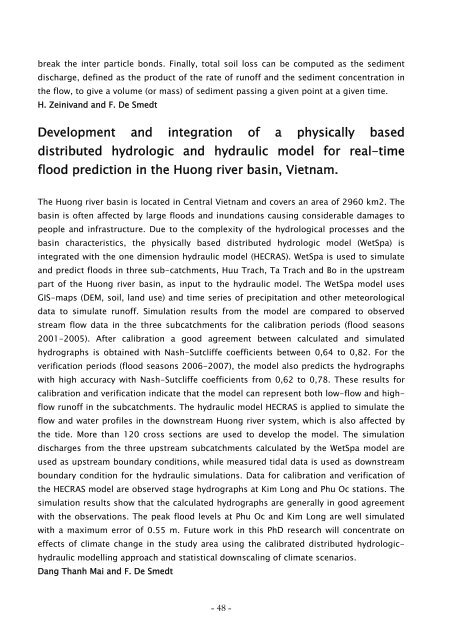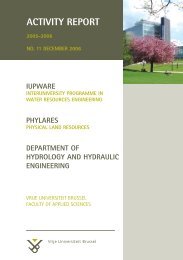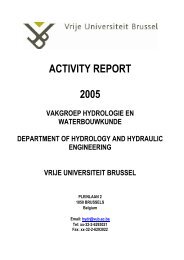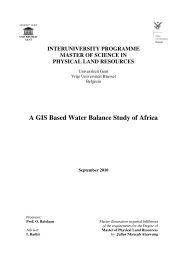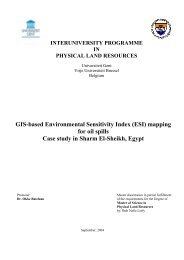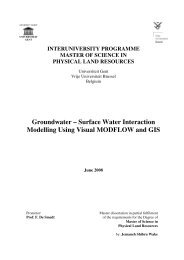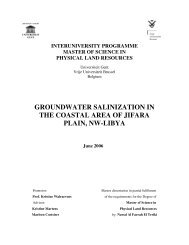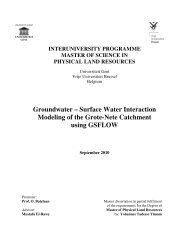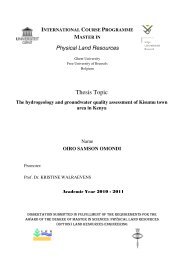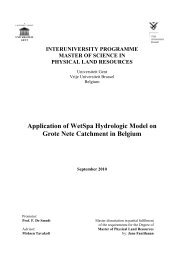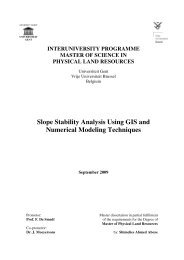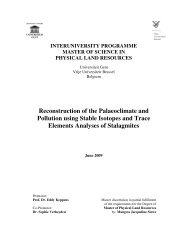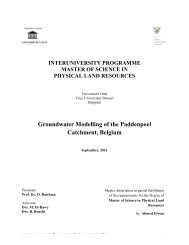C O N T E N T S - Physical Land Resources - Vrije Universiteit Brussel
C O N T E N T S - Physical Land Resources - Vrije Universiteit Brussel
C O N T E N T S - Physical Land Resources - Vrije Universiteit Brussel
You also want an ePaper? Increase the reach of your titles
YUMPU automatically turns print PDFs into web optimized ePapers that Google loves.
eak the inter particle bonds. Finally, total soil loss can be computed as the sedimentdischarge, defined as the product of the rate of runoff and the sediment concentration inthe flow, to give a volume (or mass) of sediment passing a given point at a given time.H. Zeinivand and F. De SmedtDevelopment and integration of a physically baseddistributed hydrologic and hydraulic model for real-timeflood prediction in the Huong river basin, Vietnam.The Huong river basin is located in Central Vietnam and covers an area of 2960 km2. Thebasin is often affected by large floods and inundations causing considerable damages topeople and infrastructure. Due to the complexity of the hydrological processes and thebasin characteristics, the physically based distributed hydrologic model (WetSpa) isintegrated with the one dimension hydraulic model (HECRAS). WetSpa is used to simulateand predict floods in three sub-catchments, Huu Trach, Ta Trach and Bo in the upstreampart of the Huong river basin, as input to the hydraulic model. The WetSpa model usesGIS-maps (DEM, soil, land use) and time series of precipitation and other meteorologicaldata to simulate runoff. Simulation results from the model are compared to observedstream flow data in the three subcatchments for the calibration periods (flood seasons2001-2005). After calibration a good agreement between calculated and simulatedhydrographs is obtained with Nash-Sutcliffe coefficients between 0,64 to 0,82. For theverification periods (flood seasons 2006-2007), the model also predicts the hydrographswith high accuracy with Nash-Sutcliffe coefficients from 0,62 to 0,78. These results forcalibration and verification indicate that the model can represent both low-flow and highflowrunoff in the subcatchments. The hydraulic model HECRAS is applied to simulate theflow and water profiles in the downstream Huong river system, which is also affected bythe tide. More than 120 cross sections are used to develop the model. The simulationdischarges from the three upstream subcatchments calculated by the WetSpa model areused as upstream boundary conditions, while measured tidal data is used as downstreamboundary condition for the hydraulic simulations. Data for calibration and verification ofthe HECRAS model are observed stage hydrographs at Kim Long and Phu Oc stations. Thesimulation results show that the calculated hydrographs are generally in good agreementwith the observations. The peak flood levels at Phu Oc and Kim Long are well simulatedwith a maximum error of 0.55 m. Future work in this PhD research will concentrate oneffects of climate change in the study area using the calibrated distributed hydrologichydraulicmodelling approach and statistical downscaling of climate scenarios.Dang Thanh Mai and F. De Smedt- 48 -


